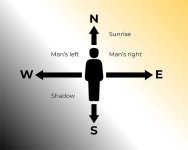Some of these
can be found in older publications.
The issue that I see is a mismatch between the available technology we see in the texts dated with "ancient" times and up to about 1850s, and the physical evidence primarily related to architecture and various pieces of infrastructure. Not limited to architecture, for we have things like these as well:
Watches and devices of this nature require specific tools and education to produce. What tools did they use and what tools did they use to produce the tools they used to build there watches, and mechanical devices? Then we have draft/project drawings normally required to build a structure, design watch or a device. What did they use to draw? They sure could not use ink and a goose feather quill to create blueprints. When one reads the
history of a pencil, it's so convoluted, lol.
When did they invent a pencil? The article ia all over the place, but it appears that more or less usable pencil came out in 1795.
- The first attempt to manufacture graphite sticks from powdered graphite was in Nuremberg, Germany, in 1662. It used a mixture of graphite, sulphur, and antimony.
- English and German pencils were not available to the French during the Napoleonic Wars; France, under naval blockade imposed by Great Britain, was unable to import the pure graphite sticks from the British Grey Knotts mines – the only known source in the world.
- France was also unable to import the inferior German graphite pencil substitute. It took the efforts of an officer in Napoleon's army to change this.
- In 1795, Nicolas-Jacques Conté discovered a method of mixing powdered graphite with clay and forming the mixture into rods that were then fired in a kiln.
- This method of manufacture, which had been earlier discovered by the Austrian Joseph Hardtmuth, the founder of the Koh-I-Noor in 1790, remains in use.
Did Napoleon fight over pencils? Lol.
And here is the "modern" pencil inventor.
- Nicolas-Jacques Conté (1755 – 1805) was a French painter, balloonist, army officer, and inventor of the modern pencil.
Then, we have pencils in America. These dates I am unable to understand, for they make no sense when compared to the above-mentioned dates.
- American colonists imported pencils from Europe until after the American Revolution.
- Benjamin Franklin advertised pencils for sale in his Pennsylvania Gazette in 1729, and George Washington used a three inches (7.5 cm) pencil when he surveyed the Ohio Country in 1762.
- William Munroe, a cabinetmaker in Concord, Massachusetts, made the first American wood pencils in 1812.
Like, who produced them pencils Franklin advertised for sale in 1729? Where did he get them from? And I don't even want to start on Franklin, What a natural dude.
- Benjamin Franklin (1706 - 1790) was an American polymath who was active as a writer, scientist, inventor, statesman, diplomat, printer, publisher, and political philosopher.
- A polymath is an individual whose knowledge spans a substantial number of subjects, known to draw on complex bodies of knowledge to solve specific problems.
Here is the oldest pencil in the world, found in timbered house built in 1630.
- Remember: the first attempt to manufacture graphite sticks from powdered graphite was in Nuremberg, Germany, in 1662.
So, if you understand when they started using pencils, please let me know

This stuff just cracks me up. They say:
- Graphite came into widespread use following the discovery of a large graphite deposit in Borrowdale, England in 1564.
What wide spread use are they talking about in 1564? No internet and a horse for transportation they had.
And before the pencil was invented, they used a
silverpoint. The problem is solved, I guess,
- A silverpoint drawing is made by dragging a silver rod or wire across a surface, often prepared with gesso or Chinese white ground.
- Silverpoint is one of several types of metalpoint used by scribes, craftsmen and artists since ancient times.
- Metalpoint styli were used for writing on soft surfaces (wax or bark), ruling and underdrawing on parchment, and drawing on prepared paper and panel supports.
- For drawing purposes, the essential metals used were lead, tin and silver.
- The softness of these metals made them effective drawing instruments.
- Goldsmiths also used metalpoint drawings to prepare their detailed, meticulous designs.
- Albrecht Dürer's father was one such craftsman who later taught his young son to draw in metalpoint, to such good effect that his 1484 Self-Portrait at the Age of 13 is still considered a masterpiece.
Naturally, who needed pencils, when you can take a metal stick and draw something like this in 1484?
Then we have measurement units. What did they use in the past? They used body parts.
Not only do I say, good luck measuring something like that for construction, but this is such a clever way to hide giants from history. King John Doe was tall for his time, standing at 6 feet tall. Whose feet?
Now, try building the
Cologne Cathedral using some metalpoint for blueprints, and body part measurements for ordering construction parts.
- Construction of Cologne Cathedral began in 1248 but was halted in the years around 1560, unfinished.
- Attempts to complete the construction began around 1814 but the project was not properly funded until the 1840s.
- The edifice was completed to its original Medieval plan in 1880.
But more than anything, I want to know the material this "medieval" 369 y.o.
(in 1868) crane was made of.
KD: It's like, should we start looking for construction robots and some type of computer or mechanical numerical control in the past? How do you build something like this Milan Cathedral using metalpoints and arm lengths. Not like we have any credible evidence of that anyways.




